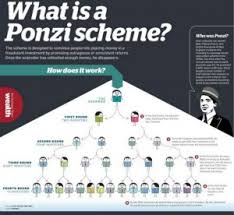This Ponzi Scheme is 100xs Bigger Than Bernie Madoff

By January 1920, much of Europe was in total chaos following the end of the first World War.
Unemployment soared and steep inflation was setting in across Spain, Italy, Germany, etc.
But an Italian-American businessman who was living in Boston noticed a unique opportunity amid all of that devastation.
He realized that he could buy pre-paid international postage coupons in Europe at dirt-cheap prices, and then resell them in the United States at a hefty profit.
After pitching the idea to a few investors, he raised a total of $ 1,800 and formed a new company that month– the Securities Exchange Company.
Early investors were rewarded handsomely; within a month they had already received a large return on investment.
Word began to spread, and soon money came pouring in from dozens, then hundreds of other investors.
By the summer of 1920, the company’s founder was receiving more than $ 1 million per day from investors.
His name was Charles Ponzi. And as you could guess, it was a total scam.
Ponzi wasn’t really generating any investment returns. He was simply taking the new investors’ money to pay the old investors.
The business collapsed later that year, giving rise to the term “Ponzi Scheme”.
The most famous Ponzi Scheme in recent history was the case of Bernie Madoff, whose scam robbed investors of $ 65 billion.
But today there’s another major Ponzi Scheme that’s literally 100x the size of Bernie Madoff’s.
I’m talking about pension funds.
Pensions are the giant funds responsible for paying out retirement benefits to workers.
And if you think calling them a “Ponzi Scheme” is sensational, it’s not.
Pension funds (including Social Security) literally make payments to their beneficiaries with money contributed by people in the work force.
In other words, the money that people pay in to the pension fund is paid out to the people receiving benefits.
In theory this could go on indefinitely as long as
a) there’s a sufficient ratio of workers paying into the system vs. retirees receiving benefits; and
b) the pension funds are receiving an adequate return on investment
When one (or both) of these conditions is not being met, the pension is considered to be “underfunded,” and it starts burning through its cash balance.
Eventually it will burn through all of the fund’s assets until there’s nothing left. Poof.
Credit-rating agency Moody’s estimates state, federal and local government pensions are $ 7 trillion short in funding.
And corporate pension funds are underfunded by $ 375 billion.
One of the big drivers behind this is that investment returns are way too low.
Pension funds need to invest in safe, stable assets (like government bonds), but have to achieve yields of around 7% per year in order to stay solvent.
But today with government bonds yielding 3% or less (and in some cases bond yields are NEGATIVE), they aren’t achieving their targets.
One or two years with sub-optimal investment returns is not catastrophic.
But it’s been like this now for a decade.
And that’s just problem #1.
Problem #2 is that the ratio between workers and retirees is moving in the wrong direction.
As an example, despite all the hoop-lah about the unemployment rate falling in the Land of the Free, the number of retirees receiving Social Security is rising MUCH more rapidly.
Ten years ago in November 2007, the Bureau of Labor Statistics calculated that 146 million Americans were working.
Today that figure is 153 million, a 4.8% increase over the past decade.
Social Security, on the other hand, was paying benefits to 34.4 million Americans in November 2007, versus 44.2 million today– a 28.5% increase.
These are government statistics– and the numbers clearly show a terrible trend: there aren’t enough workers to pay for retirees.
The problems persists across state and local pensions as well.
The State of Kentucky’s Teachers’ Retirement System, for example, saw a 64% increase in retirees just in the last twelve months.
Unsurprisingly Kentucky’s retirement system is massively underfunded.
It’s so bad that Governor Matt Bevin is publicly attacking teachers who retire early (early retirement means that someone is taking benefits sooner and paying less into the pension fund).
Bottom line– this trend is real:
– Pension funds are earning a lower investment return than they require
– The ratio of people paying in to the fund vs. people receiving benefits is moving in the WRONG direction.
This is how Ponzi schemes invariably unravel.
Again, I’m not trying to be sensational. These are facts.
And given that just about everyone at some point probably plans on retiring, it’s important to be able to have an objective, data-driven conversation about the topic.
I know it’s uncomfortable. We want to believe so badly that the system is going to work.
I also want to be the starting Quarterback of the Dallas Cowboys. But that’s probably not going to happen either.
Retirement is a BIG component of a Plan B– which is fundamentally about taking sound, sensible steps to be in control of your own fate.
And there ARE plenty of options.
For example, you can look into a self-directed SEP IRA or Solo(k), which both allow you to contribute 10x more each year for retirement than a conventional structure.
Plus these structures allow you greater flexibility in where you can invest your retirement savings– real estate, lucrative private businesses, even cryptocurrency.
Just ONE great investment through a more flexible structure can make an enormous difference to your retirement.
And even if the Ponzi pension crisis somehow miraculously rights itself, you certainly won’t be worse off having your own independent nest egg.
It just makes sense… no matter what happens (or doesn’t happen) next.
